Are Modified Atmosphere Systems Right For You?
Knowing the Atmospheric Composition During Handling and Transport is Crucial for Product Quality

The demand for a year-round supply of high-quality fresh fruits and vegetables poses daily challenges and opportunities to growers, intermediaries and retailers. Even after harvest, fruit and vegetables are metabolically active and respire; every day of post-harvest life poses the risk of rapid deterioration, microbial degradation, loss of freshness, changes in colour and flavour, and ultimately senescence of the produce. Maintaining quality and shelf life is a complex problem.
At Sensitech we know that correct handling and good temperature control are essential factors in preserving the post-harvest life of fresh produce. However, there are other factors to think about, and atmospheric composition around the produce during handling and transport can be a crucial element. This is where modified atmosphere systems come in.
Modified atmosphere (MA) and controlled atmosphere (CA) technologies regulate atmospheric composition during storage, staging, and/or transport. Typically, MA/CA environments for fresh produce are characterised by a higher concentration of carbon dioxide (CO2) and a lower concentration of oxygen than is usually present in the air. Such conditions slow down the respiration of the product, reducing the production of ethylene and the activity of aerobic organisms. As a result, in conjunction with good postharvest practices, MA/CA systems can further extend the shelf life of produce.
When MA/CA systems are used, gas levels play an essential role in maintaining the safety of the produce. Ideal levels of CO2 and O2 depend on various aspects such as the species, variety, maturity, ripeness of the product, packaging material, post-harvest handling temperature, and humidity. These systems are designed to adjust the air mixture according to the needs of the product in order to prevent any adverse effects.
So, how do you know if a modified atmosphere system is right for you?
Advantages:
- Maintain quality and extend the shelf life of produce by reducing its respiration, cutting down on waste at the retail end.
- Increase post-harvest life of climacteric fruit (for example, bananas and avocados) and those with a high rate of metabolism (for example, asparagus).
- Inhibit ripening. Low levels of O2 and/or CO2 (8% or below for O2, 1% for CO2) can inhibit fruit sensitivity to ethylene, which is a plant hormone that encourages ripening and senescence. Elevated CO2 levels can combat the presence of ethylene, delaying premature ripening and softening.
- Inhibit microbial growth. Elevated CO2 and low O2 levels have fungistatic and bacteriostatic effects. For example, high concentrations of CO2 (15%) hamper the growth of Botrytis cinerea (grey mold) in soft fruit such as strawberries and raspberries.
- Slow the yellowing of green tissues (broccoli, leafy vegetables) by preventing chlorophyll degradation.
Disadvantages:
- Exposure to very low O2 levels may lead to anaerobic respiration (fermentation) and the accumulation of ethanol and acetaldehyde, resulting in an altered flavor and/or odor.
- Physiological disorders such as blackheart in potatoes, brown stain in lettuce, or brown heart in apples and pears may be caused by exposure to very high CO2 levels.
- Softening or black blotches on green bananas due to high levels of CO2 and high-temperature transport.
- May not be the right approach for certain fresh produce. For example, sulphur dioxide (SO2) treatments and high relative humidity management are more beneficial in extending the postharvest life of grapes than MA/CA systems.
- Can be ineffective in the case of modified atmosphere packaging (MAP) solutions, if the packaging material is torn or damaged.
- Increased cost for equipment, transport, packing materials, and gases needed for the gas mixture.
- Require specialized staff members for operation.
For some fresh produce, the disadvantages and costs of modified atmosphere technologies may outweigh the benefits. In an upcoming post, we’ll explore the MA/CA technologies available today. But whether or not these solutions are right for you, it’s important to consider every angle of produce freshness—and in many cases, atmosphere is key.

Above: Ripening control comparison. Source: container.carrier.com
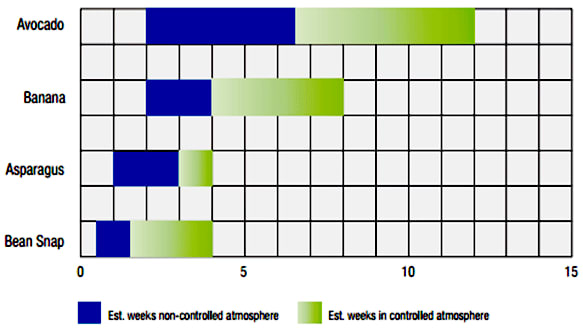
Above: Controlled atmosphere optimum transport conditions. Source: www.carrier.com (cited from University of California at Davis and the former Davis Fresh Technologies, LLC)
Modified and Controlled Atmosphere: Today’s Technologies
When it comes to freshness in the produce supply chain, keeping a close eye on atmospheric conditions is just as critical as monitoring temperature. Recently developed technologies known as modified atmosphere (MA) and controlled atmosphere (CA) systems regulate this aspect of quality during transport. MA/CA systems expose fresh produce (fruits, vegetables, and flowers) to a higher concentration of carbon dioxide (CO2) and lower concentration of oxygen (O2) than is normally present in the air. Controlling the gases responsible for the natural senescence of fresh produce can help maintain quality for a longer period of time and extend postharvest life.
Modified atmosphere (MA) systems measure and control of gas levels at a broad level. Gas levels are allowed to fluctuate over time in the natural course of produce interaction.
Controlled atmosphere (CA) systems strictly measure and control atmospheric gas levels within the refrigerated space. The gas levels are mechanically maintained at the desired limits for the entire trip period.
MA/CA technologies can be applied on a large scale within a pallet or whole container, or within smaller refrigerated spaces down to individual packs.
Modified atmosphere (MA) systems
1. Polyethylene pallet covers
This technology is often used for shipping non-climacteric fruit such as strawberries, cherries and raspberries, which tolerate high CO2 levels. High CO2 concentrations greater than (15%) create an antibacterial effect. Individual pallets are covered with a polyethylene cover/shroud and sealed at the base using tape or heat seals. The desired gas mixture is then injected into the cover.
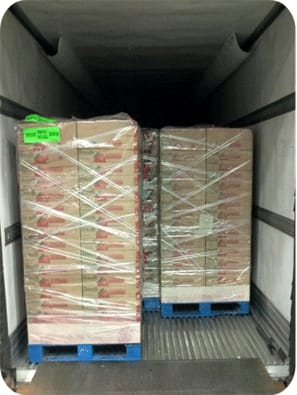
2. Polyethylene liners/bags for boxes
Polyethylene liners (bags) create an MA environment within a carton/box of produce during transit. This technique is often used in-transit for produce such as cherries or bananas. For example, transporting bananas using polyethylene liners, also known as a Banavac system, increased the postharvest life of the fruit by up to 50-60 days.
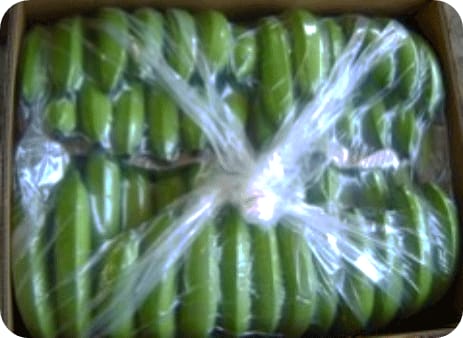
3. Modified atmosphere packaging (MAP)
MA systems are also used within individual packages. Packaging material which allows some gas permeability is used to keep gas levels relatively steady over time. The desired gas ratio can be achieved actively by inserting a gaseous mixture into the package, or passively as a result of the produce’s respiration, which involves O2 consumption and CO2 production.
4. eAutoFresh™ by Carrier Transicold
This eAutoFresh ventilation system uses a CO2 software-controlled sensor to precisely control the fresh air exchange rate within a shipment. The ventilation units are transferable between container units equipped with a ML2i or ML3 controller. This system is an energy-saving alternative to systems which continuously vent refrigerated containers.
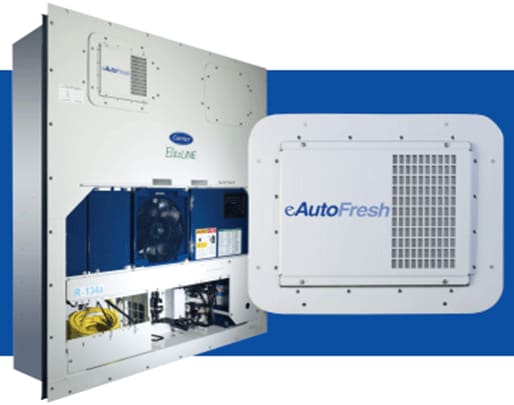
Controlled atmosphere (CA) systems
1. EverFRESH® system by Carrier Transicold
EverFRESH® uses fresh air and nitrogen (N2) to maintain desired O2 and CO2 levels within a container. The system is fitted with a N2 generator membrane, which separates N2 from the outside atmosphere and injects it into the container. If O2 drops below the desired level, air vents automatically open to let fresh air in. A CO2 bottle can also be added, if the levels of CO2 required are higher than what the produce can naturally generate.
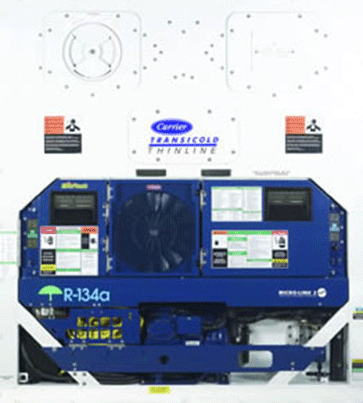
2. XtendFRESH™ system by Carrier Transicold
The XtendFRESH™ system is fitted with O2 and CO2 sensors, as well as a carbon scrubber which controls CO2 and ethylene (C2H4). It also uses a door curtain to create a tight seal within the container. The XtendFRESH is a modular system which can be installed on container refrigeration units with Micro-Link® 3 controllers, and can maintain levels of 3-21% O2 and 0-19% CO2. Higher CO2 levels are possible with the addition of an optional CO2 bottle. If O2 levels drop below the desired level, air vents automatically open to let fresh air in.
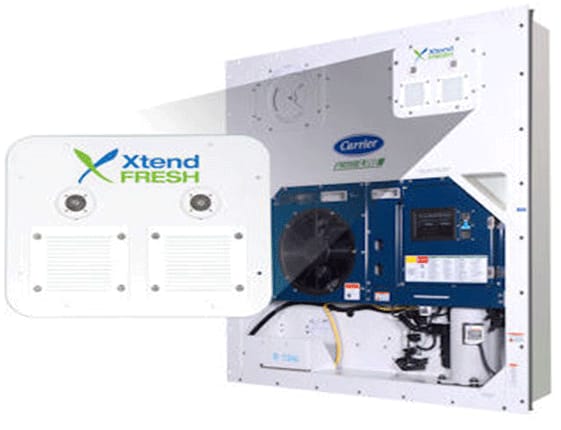
MA and CA technologies are becoming increasingly popular for the transport of fresh produce all over the world. They can be as simple as a packaging method that regulates gas levels more effectively, or as complex as the CA ventilation systems seen above. Whatever path you choose, MA/CA systems can help you take control of an essential factor in produce freshness.
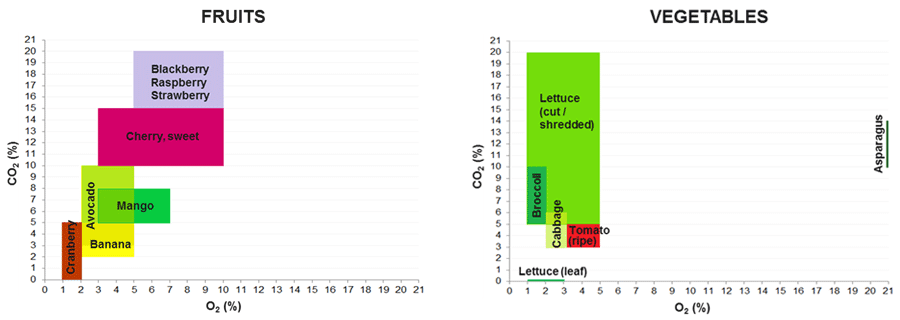
Fig 1: Recommended CA/MA conditions for some common fresh fruit and vegetables. Data compiled from Kader, et al., 1989; Kader, et al., 2002; Danish Technological Institute, 2008; Baroni, et al., 2009; ICCT, 2014.
Sensitech combines strong food industry expertise and cold chain best practices with state-of-the-art monitoring technology and analytics to help food producers, shippers and buyers ensure the quality and freshness of their food products worldwide. Contact us today to learn more about how our CO2 studies and how Sensitech Cold Chain Solutions can help drive process improvements and improve your bottom line.

